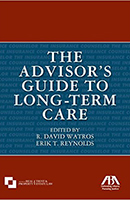 VERDICT: Touchdown!
VERDICT: Touchdown!
The Biology of Consciousness
By Thomas J. Erickson (Sheboygan, WI: Pebblebrook Press, 2016). Poetry. 69 pgs. $15.
Order, www.amazon.com.
Reviewed by Fritz Knaak
If you never own or buy another book of poetry of any kind, you owe it to yourself to get Wisconsin trial lawyer Thomas Erickson’s delightful The Biology of Consciousness.
Known to many people for his earlier collection, The Lawyer Who Died in the Courthouse Bathroom, Erickson has used his life experience in the legal trenches here in Wisconsin to create images and craft superb poems of the very first order. Many focus on what he sees in his everyday existence in the sea of stressed humanity that shows up in courthouses and how he feels and what it does to him.
This isn’t supposed to happen, of course. I remember my second day in property class when my professor announced that novels and literature would henceforth be dead to us as future lawyers, our use and knowledge of language soon to be ground to a pulp and reformed into the grey bricks that so often is legal writing.
But Erickson is no dabbler. He has lived life in the way a keenly observant lawyer would, and he takes the full measure of that life in his work. His use of language to craft these poems gives the kind of pleasure in the plain chant of midwestern American English that fans of Kooser and Bly will certainly appreciate.
Want to Review a Book?
Please request a book and writing guidelines from Wisconsin Lawyer managing editor Karlé Lester, at klester@wisbar.org or (608) 250-6127. Reviewers may keep the book reviewed. Reviews of about 500 words are due within 45 days of receiving the book. Reviews are published, space permitting, in the order received and may be edited for length and clarity.
In one poem, “Court Appearances,” he asks the most obvious question: “Where is the poetry in this/boxy room with sallow walls and/carpeting the color of sludge?” “Have any of you – Judge, DA, Bailiff – /ever read the darkly lyrical Larkin while/a client was being deposed or tried/to write a villanelle between appearances?” We know, of course, the answer is “no,” and we are left to understand that we are poorer for it.
A poetic sensibility in a courtroom is a wonder to behold. Who hasn’t fought off the fatigue-induced tendency to drift off and lose focus in a trial? In “The Floating Man,” Erickson describes one such experience for himself:
“It started during a trial. I was sitting there listening to the DA’s/opening statement when I started floating about the courtroom, /over the judge, the jurors, the bailiffs, the victim’s family/wearing matching shirts with his superimposed photo/I could even see me – whispering to my client, taking notes, /staring into space. I looked tired and I needed a haircut….”
But the bizarre and grim – and occasionally darkly amusing – reality of a lawyer’s life is also part of these poems, as in “Word,” in which he writes:
“I represent drug clients with the given first/ names of Kilo and Easy Money, who sell/ teenagers (one-eighth grams of heroin) to teenagers. / I have two teenagers. / HIDTA (pronounced high-da), an acronym/ for High Intensity Drug Trafficking Areas, / is an anti-crime task force. My client keeps/ complaining that Al Qaeda is after him.”
It’s not all about the courtroom and being a lawyer for Erickson, though. One poem, “Milwaukee,” a richly descriptive portrait of the city, would be worth its own review.
Steal this book.
Fritz Knaak, Minnesota 1978, practices with Holstad & Knaak PLC, North Oaks, Minn.
 VERDICT: Touchdown!
VERDICT: Touchdown!
The Future of the Professions: How Technology Will Transform the Work of Human Experts
By Richard Susskind & Daniel Susskind (New York, NY: Oxford Univ. Press, 2016). 346 pgs. $17.95. Order, www.amazon.com.
Reviewed by Jennifer Herzog
Imagine reading your own obituary years in advance of your demise. Such is the grim view into the future of lawyering offered by The Future of the Professions. The well-informed and delightfully eloquent authors of this book use its pages to posit that the professions as we know them (especially the law profession) are somewhat bound for extinction (or, at the very least, a radical evolution), as technology revolutionizes the nature of professional work.
Though this description suggests that this book is filled with technical jargon and an overall sense of foreboding, it makes for a surprisingly enjoyable read. The authors offer interesting, accessible examples and discussions of the structure of professions, the place of the professions (and professionals) in society, and the basis for the eventual downfall (or at least the dramatic metamorphosis) of the professional.
Most professionals (especially that rare creature, the argumentative attorney) are likely to oppose such a premise, citing a variety of factors that will preserve their profession in the face of adversity. The authors have anticipated these arguments and carefully dissected each one. If there is any complaint to be made about this book, it is that it is so frustratingly thorough that any argument to the contrary of the authors’ conclusions seems futile, such that one must ask – why bother continuing to practice law at all if the future is so bleak?
Here too the authors are complete in their analysis. They do not suggest that the practice of law will necessarily be eliminated altogether; however, the profession will be dramatically transformed such that the lawyers of tomorrow may be unrecognizable to the lawyers of today. It is with this warning that the true value of reading this book comes to play. To appreciate the radical change the field will likely undergo, and to be prepared to change with it, will mean the difference between being left behind and evolving to survive.
Sitting on the precipice of change is an issue that concerns all attorneys. Whether you are an individual lawyer who needs to be reminded that preferring to do things “the old-fashioned way” today could equate to malpractice tomorrow, or the head of a law firm who should heed the warning that the old billing models are no longer sustainable in a modern, output-focused society, this book offers insight for all. One of the most important takeaways from this book is that we, the lawyers, are no longer the driving force of change in our field. While this might make us all the more resistant to such change, it is all the more reason that we must be proactive in paying attention to it.
This book also forces professionals to ask deeper questions as well – such as how much we value the mystification of our work and the related respect it earns us. Are we ready and willing to sacrifice these aspects of our profession and perhaps compromise what it means to be a “professional” altogether? These thought-provoking and often uncomfortable ideas are well worthy of consideration.
Overall, this book offers an important, interesting, and valuable insight into the future transformation of the lawyer and the practice of law. As such, it is a recommended read for all legal professionals.
Jennifer Herzog, Illinois 2005, is university legal counsel at the University of Wisconsin - Milwaukee.
 VERDICT: It’s a Keeper
VERDICT: It’s a Keeper
The Advisor’s Guide to Long-Term Care
Edited by R. David Watros & Erik T. Reynolds (Chicago, IL: ABA Real Property, Trust & Estate Law Section, 2013). 255 pgs. $79.95. Order, www.shopaba.org.
Reviewed by Lori Kornblum
If you know anyone who is older and has required nursing home care, assisted living, or in-home care, you probably are painfully familiar with the costs associated with this care. Private-pay nursing home care can run more than $10,000 per month. Assisted living can be $5,000 or $6,000 per month, depending on where the person is. Chances are that your loved one or client was not prepared for paying for this type of care and did not have long-term care insurance. Most people do not know much about long-term care costs or insurance.
This book is designed to get you, the lawyer, to discuss long-term care needs with your clients and help prepare them for the stage of life when they might need it. It does so by explaining why people need to think about long-term care, what are the costs (in 2013 dollars), and what are the benefits of long-term care products. The book provides a persuasive argument to present to clients and family members about why they should think about long-term care.
It also provides thorough explanations of the current insurance products relating to long-term care and how they all interact. The editors of the book explain the benefits available through these products and how they intersect with current tax law. If you are an employer, the authors have provided guidance for establishing long-term care as a company benefit, including a sample corporate resolution establishing this benefit.
Some caveats to the book: First, it is dated. The book was published in 2013, and according to correspondence with the editors, they have no plans to revise it. Thus, the information on insurance products and rates, as well as tax implications, might not be accurate when you read the book, especially if the tax code changes. As with any legal advice, you would need to do further research to ensure you are presenting the best information.
Second, do not confuse this book with another book of the same title, The Advisor’s Guide to Long Term Care, by Forman and Sadler (the second edition published in 2017). The Forman and Sadler book is not a second edition of the book that is the subject of this review, according to this book’s editors. This book’s editors have no relationship to the authors and publishers of Sadler and Forman.
Finally, the editors of this book are associated with M Financial Group, which sells long-term care insurance. This relationship makes them either experts or disqualifies them, depending on your perspective. To their credit, the editors disclose this relationship and throughout their book, recommend several alternative sources for purchasing long-term care insurance. They do not direct business to their organization. In this case, their expertise as being involved in the business of long-term care insurance is very informative.
Overall, this book is a “keeper.” You can use it as a guide to explain the products and their necessity, but do not rely on it for rates and final legal advice.
Lori S. Kornblum, Boalt Hall Law School UC-Berkeley 1982, is a tenured faculty member at Milwaukee Area Technical College, Department of Paralegal Studies; an adjunct faculty member, Marquette University Law School; and in private practice focusing on child abuse and neglect, private termination of parental rights, and adult guardianship and disability issues.
